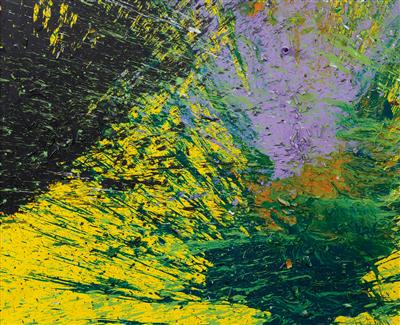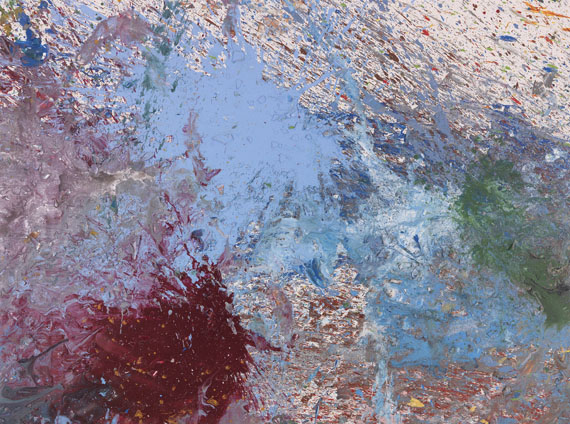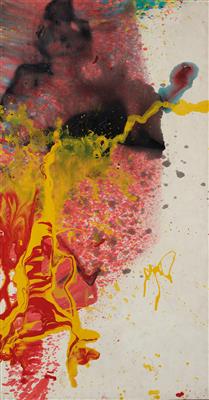Shozo Shimamoto Untitled 《無題》 2010 acrylic and broken glass on canvas 162.5 x 130.2 cm. (63 7/8 x 51 1/4 in.) Executed in 2010, this work is accompanied by a certificate of authenticity issued by the Shozo Shimamoto Association.
Provenance Tachibana Gallery, Tokyo Acquired from the above by the present owner Catalogue Essay Shozo Shimamoto’s oeuvre is one that reifies motion. Each of the artist’s works is a physicalisation of Shimamoto’s energy and vigour, where glass, pigment and canvas converge. During the 2nd ‘Gutai Art Exhibition’ in 1956, Shimamoto drastically developed and altered his modus operandi, and presented to a global audience his new artistic technique. Setting a large canvas onto the ground with a rock anchored at its centre, the artist smashed countless glass bottles containing coloured pigments to create a sprawling, vibrant piece. Even after the disbanding of the Gutai group in 1972, Shimamoto’s sensational working method and energetic canvases continued to gain a critical following, and in 1993 the artist was invited to perform the 'Bottle Crash' at the 45th Venice Biennale. His works have since been coveted by prestigious institutions, including the Tate Modern, and Shimamoto has been invited to present his 'Bottle Crash' performances internationally. In his early career, the great master Jiro Yoshihara became tutor to Shimamoto, and the two later co-founded the Gutai group in 1954. Under Yoshihara’s tutelage, Shimamoto sought to break all existing artistic paradigms and modes of creation. In his 1957 article, 'The Idea of Executing the Paintbrush', Shimamoto boldly states, 'I believe that the first thing we should do is set paint free from the paintbrush.' (Shozo Shimamoto, 'The Idea of Executing the Paintbrush', taken from Doryun Chong, Michio Hayashi, Kenji Kajiya, Fumihiko Sumitomo, eds., From Postwar to Postmodern: Art in Japan 1945 – 1989, MoMA Primary Documents, The Museum of Modern Art, New York, 2012). Believing that pigments should not be beholden to the brush, Shimamoto bottled his medium of choice and released them onto his canvases. The present piece, Untitled, captures the essence of the artist’s energy and philosophy, and is a mature rendition of his technique. Far from a dilution of the first 'Bottle Crash' prototype in 1956, the present work is a burst of bold colours representing the culmination of more than half a century’s worth of Shimamoto’s artistic practice and development. Notably, in each of his artworks, destruction and creation are paradoxically aligned and a symbiotic relationship is formed: where the smashing of one element paves the way for its physicality. Fittingly, Shimamoto’s bottling of paint engages with the very essence of 'Gutai' ('Concreteness' in Japanese)—as instructed by Yoshihara, all aspects of artistic creation must be connected with beyond just theory; it must take on a physical quality and be embodied in praxis. Perhaps most strikingly, Untitled is a palpable product of Shimamoto’s relinquishment of stringent rules and impositions. It is a piece that resolutely defies the conventional deployment of paint, and in its formless abstraction, Untitled simply yet succinctly compels its audience to truly engage with Shimamoto’s powerful mastery of depicting both the malleability and concreteness, bottling and freeing, of paint itself. Read More
Shozo Shimamoto Untitled 《無題》 2010 acrylic and broken glass on canvas 162.5 x 130.2 cm. (63 7/8 x 51 1/4 in.) Executed in 2010, this work is accompanied by a certificate of authenticity issued by the Shozo Shimamoto Association.
Provenance Tachibana Gallery, Tokyo Acquired from the above by the present owner Catalogue Essay Shozo Shimamoto’s oeuvre is one that reifies motion. Each of the artist’s works is a physicalisation of Shimamoto’s energy and vigour, where glass, pigment and canvas converge. During the 2nd ‘Gutai Art Exhibition’ in 1956, Shimamoto drastically developed and altered his modus operandi, and presented to a global audience his new artistic technique. Setting a large canvas onto the ground with a rock anchored at its centre, the artist smashed countless glass bottles containing coloured pigments to create a sprawling, vibrant piece. Even after the disbanding of the Gutai group in 1972, Shimamoto’s sensational working method and energetic canvases continued to gain a critical following, and in 1993 the artist was invited to perform the 'Bottle Crash' at the 45th Venice Biennale. His works have since been coveted by prestigious institutions, including the Tate Modern, and Shimamoto has been invited to present his 'Bottle Crash' performances internationally. In his early career, the great master Jiro Yoshihara became tutor to Shimamoto, and the two later co-founded the Gutai group in 1954. Under Yoshihara’s tutelage, Shimamoto sought to break all existing artistic paradigms and modes of creation. In his 1957 article, 'The Idea of Executing the Paintbrush', Shimamoto boldly states, 'I believe that the first thing we should do is set paint free from the paintbrush.' (Shozo Shimamoto, 'The Idea of Executing the Paintbrush', taken from Doryun Chong, Michio Hayashi, Kenji Kajiya, Fumihiko Sumitomo, eds., From Postwar to Postmodern: Art in Japan 1945 – 1989, MoMA Primary Documents, The Museum of Modern Art, New York, 2012). Believing that pigments should not be beholden to the brush, Shimamoto bottled his medium of choice and released them onto his canvases. The present piece, Untitled, captures the essence of the artist’s energy and philosophy, and is a mature rendition of his technique. Far from a dilution of the first 'Bottle Crash' prototype in 1956, the present work is a burst of bold colours representing the culmination of more than half a century’s worth of Shimamoto’s artistic practice and development. Notably, in each of his artworks, destruction and creation are paradoxically aligned and a symbiotic relationship is formed: where the smashing of one element paves the way for its physicality. Fittingly, Shimamoto’s bottling of paint engages with the very essence of 'Gutai' ('Concreteness' in Japanese)—as instructed by Yoshihara, all aspects of artistic creation must be connected with beyond just theory; it must take on a physical quality and be embodied in praxis. Perhaps most strikingly, Untitled is a palpable product of Shimamoto’s relinquishment of stringent rules and impositions. It is a piece that resolutely defies the conventional deployment of paint, and in its formless abstraction, Untitled simply yet succinctly compels its audience to truly engage with Shimamoto’s powerful mastery of depicting both the malleability and concreteness, bottling and freeing, of paint itself. Read More
.jpg)






.jpg)




.jpg)
.jpg)

Try LotSearch and its premium features for 7 days - without any costs!
Be notified automatically about new items in upcoming auctions.
Create an alert